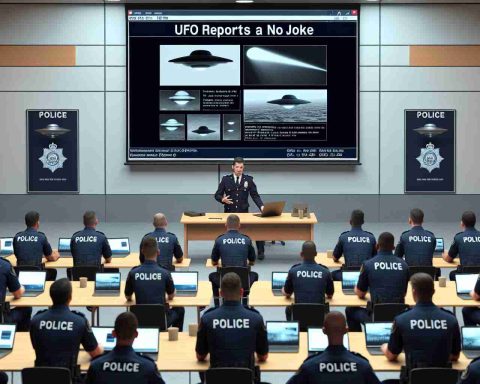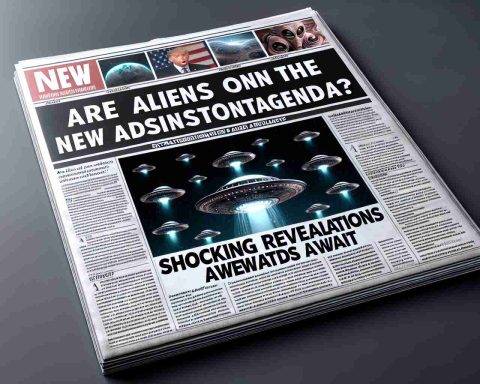A Modern Twist on Age-Old UFO Mysteries
Unidentified flying objects, or UFOs, have baffled and entranced humans for decades. In our technologically advanced age, this fascination has only intensified, reaching new heights on the digital stage. A recent video purporting to capture a UFO crash in Arizona exemplifies this growing trend. The footage, initially shared by Instagram user sybervisions_, depicts a team clad in hazmat suits inspecting an enigmatic object, creating a scene that intrigued millions. However, the truth behind this viral phenomenon is far from extraterrestrial; it was meticulously crafted using sophisticated artificial intelligence technologies.
Unveiling the Art of Digital Deception
The proliferation of AI tools capable of generating hyper-realistic images and videos has revolutionized the nature of UFO sightings. Through techniques such as deepfakes and generative adversarial networks, creators can produce compelling audiobooks and visuals that challenge the viewer’s perception of reality. These advances have sparked both intrigue and concern, as distinguishing genuine sightings from digital fabrications becomes increasingly challenging.
The Dual Edge of AI Innovation
Engagement and Enigma: On one hand, AI-generated content draws people into discussions and fuels an already vibrant culture of extraterrestrial speculation. Such creations can serve as fascinating entertainment, stirring imaginations and prompting scientific curiosity.
Misinformation and Misunderstanding: Conversely, these capabilities pose significant risks. The spread of convincing yet false information may erode public confidence in media and undermine legitimate research into unexplained phenomena.
Embracing the Future with Caution
As AI technology marches forward, it remains vital for audiences to develop a critical eye when engaging with extraordinary claims. Tools and techniques for verifying the authenticity of digital content will likely become integral to separating fact from fiction. In the meantime, as we navigate this digital era teeming with AI wonders, a healthy dose of skepticism might be our best ally.
Digital Deception: The Environmental and Societal Impacts of AI-generated Phenomena
In recent years, the blend of advanced artificial intelligence and age-old intrigue over unidentified flying objects (UFOs) has resulted in both fascination and concern. The recent viral phenomenon of a purported UFO sighting in Arizona—later revealed to be an AI-generated fabrication—highlights not only the divide between reality and digital manipulation but also sparks a dialogue about the broader implications of such technologies on our environment, society, and future.
Environmental Impact: The Digital Carbon Footprint
One direct effect of AI advancements, including the creation of hyper-realistic digital content, is the environmental footprint of the technology itself. AI tools, particularly those involved in generating high-definition images and videos, require substantial computational power. The environmental cost of running these massive datasets and complex algorithms is significant, contributing to increased energy consumption and carbon emissions.
Data centers that host and process AI-driven applications and services are heavily reliant on electricity, often sourced from fossil fuels. As the demand for AI content grows, the energy consumption—and consequently, the carbon footprint—of these facilities is expected to rise, presenting new challenges in achieving global climate goals. Thus, while AI offers exciting possibilities, its environmental impact calls for more energy-efficient processing technologies and a stronger emphasis on sustainable practice implementation.
Societal Impact: The Challenge of Media Literacy
The societal ramifications of the rise in AI-generated content, including digital deceptions like the Arizona UFO sighting, underscore a pressing need for improved media literacy. As misinformation becomes more sophisticated and widespread, public trust in traditional media and scientific research could be undermined. If left unchecked, this erosion of trust might fuel skepticism towards genuine scientific endeavors and legitimate environmental concerns, challenging efforts to mobilize public support for critical issues such as climate change action.
Education systems and policymakers must prioritize the development of critical thinking and media literacy skills. Teaching individuals to identify and critically evaluate digital content is essential in cultivating an informed citizenry equipped to navigate the complexities of a world increasingly shaped by AI.
Future Implications: Balancing Innovation with Responsibility
Balancing the dual edge of AI innovation—encompassing both beneficial applications and potential for misuse—will be crucial for shaping a sustainable future for humanity. Responsible AI development, transparent content regulation, and ethical guidelines are imperative in harnessing the positive potential of these technologies while mitigating their negative impacts.
In fostering a culture of awareness and responsibility, societies can ensure that technology serves as a tool for progress rather than a source of division or environmental harm. The future of humanity hinges not only on embracing technological advances but on wielding them wisely to preserve both our planet and the integrity of information that shapes our understanding of it.
Are AI-Generated UFO Sightings Redefining Alien Encounters?
The Digital Revolution in UFO Narratives
In today’s digital landscape, the blend of artificial intelligence and creative storytelling is transforming the way we perceive UFO phenomena. Over the past decade, technological advancements have enabled the creation of hyper-realistic imagery and videos, often blurring the line between reality and fiction. One such captivating instance is the purported UFO crash site footage from Arizona, which has sparked considerable attention online. As it turns out, the clip is a product of sophisticated AI techniques, challenging our traditional views on unidentified flying objects.
Innovations in AI Technologies
The capabilities of AI in generating lifelike visuals and narratives are profound, employing methods such as deepfakes and generative adversarial networks (GANs). These technologies empower creators to craft content that closely mimics real-world events, leading to a surge of material that can deceive even the most discerning viewer. The implications of these advancements extend beyond entertainment, affecting fields such as journalism, research, and media literacy.
Navigating the Pros and Cons
Pros:
– Creative Engagement: AI-generated content offers new forms of entertainment and educational material, prompting discussions on space exploration and the possibilities of extraterrestrial life.
– Enhanced Storytelling: These tools provide creators with novel ways to engage audiences, pushing the boundaries of traditional storytelling.
Cons:
– Spread of Misinformation: There is a growing risk of spreading misleading information that can cloud scientific inquiry and public understanding of true UFO research.
– Diminished Trust: As fabricated content becomes increasingly convincing, distinguishing between fact and fiction may undermine trust in media sources.
Future Trends and Security Concerns
The rise of AI-generated content calls for an evolution in how audiences appraise digital media. With the potential risks of misinformation everpresent, digital literacy and content verification tools are pivotal in maintaining the integrity of information. Moreover, innovations in AI detection methods and partnerships between tech companies and educational institutions could fortify defenses against deceptive content.
Predictions and Market Analysis
Moving forward, the market for AI content creation will likely grow, driven by demand from sectors such as entertainment, advertising, and education. The ability to craft immersive experiences without the constraints of physical production presents lucrative opportunities. However, balancing these innovations with public accountability and ethical standards will be crucial in shaping a future where AI-generated materials enhance rather than obfuscate understanding.
For more insights on AI and its impact on media, visit OpenAI or Tesla. As technology evolves, remaining informed is essential to navigating the complexities of our digital world.




















